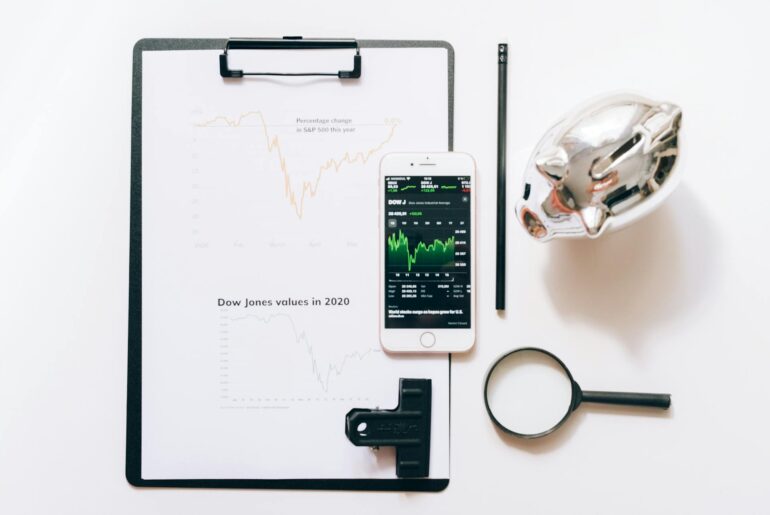This article may contain references to products or services from one or more of our advertisers or partners. We may receive compensation when you click on links to those products or services. Nonetheless, our opinions are our own.
The information presented in this article is accurate to the best of our knowledge at the time of publication. However, information is subject to change, and no guarantees are made about the continued accuracy or completeness of this content after its publication date.
- How Index Trading Works and Why Investors Use It
- How Index Trading Reduces Risk and Improves Portfolio Balance
- What Is Index Trading?
- How Indices Represent Market Segments
- How Indices Help Build Diversified Investment Strategies
- How Index Trading Works in Practice
- Types of Indices to Trade
- How to Start Trading Indices
- Risks and Potential of Index Trading
- Comparison With Other Investment Options
- Final Thoughts
- Frequently Asked Questions
- Recommended Reads
How Index Trading Works and Why Investors Use It
Index trading offers diverse investment opportunities, reducing risks compared to trading individual stocks. It allows investment in a mix of assets representing various market sectors or entire economies. Traders leverage both technical and fundamental analysis to determine the best times to buy and sell indices. Tools such as CFDs, futures, and options cater to different trading styles and risk levels. Index trading can lead to long-term growth or quick profits, depending on your strategy.
How Index Trading Reduces Risk and Improves Portfolio Balance
Balancing risk and reward is essential in finance, and index trading is a smart way to achieve this. By combining diverse investments, index trading lowers risks compared to buying individual stocks. Once you understand its mechanics, you can tap into broader market trends and enhance your financial strategies.
What Is Index Trading?
Index trading involves tracking a group of assets such as stocks, bonds, or commodities organized by industry, sector, or market capitalization. Rather than purchasing each asset individually, traders use tools like CFDs or futures contracts to follow index movements.
This approach allows investment in multiple assets, reducing risks associated with concentrating on a single stock. Index values fluctuate based on the performance of their components, providing traders opportunities to profit from these changes.
How Indices Represent Market Segments
A stock index represents the performance of a group of stocks, often listed on a specific exchange. Think of it as a basket that reflects a segment of the market. Stocks within the basket are selected based on factors like market capitalization or investment focus (e.g., growth or value).
Popular indices include:
- Dow Jones Industrial Average (DJIA): Tracks 30 major U.S. companies.
- S&P 500: Includes 500 large-cap U.S. stocks across diverse sectors.
Indices provide a snapshot of market or sector performance, helping investors gauge their strategies against the broader market.
How Indices Help Build Diversified Investment Strategies
Indices play a key role in building diversified portfolios. Instead of focusing on individual stocks, index trading spreads investments across multiple assets, minimizing the impact of poor performance from any single component.
For example, during economic downturns, sectors like consumer staples or healthcare tend to outperform others. By holding indices spanning both defensive and growth sectors, investors can better protect their portfolios from volatility.
Additionally, index trading can lower costs compared to managing multiple individual stock transactions, streamlining the investment process.
Voted "Best Overall Budgeting App" by Forbes and WSJ
Monarch Money helps you budget, track spending, set goals, and plan your financial future—all in one app.
Get 50% OFF your first year with code MONARCHVIP
How Index Trading Works in Practice
Index trading differs from buying individual company shares, as it often involves derivatives like CFDs (Contracts for Difference). With CFDs, traders speculate on index price movements without owning the underlying assets.
- Going Long: Buying if you expect the index to rise.
- Going Short: Selling if you predict the index will fall.
This flexibility, combined with leverage, can amplify profits but also increases potential losses. Traders must exercise caution and robust risk management.
Types of Indices to Trade
Index trading offers various options tailored to investor goals and risk appetites:
- Broad Market Indices: Reflect entire markets (e.g., S&P 500, FTSE 100, Nikkei 225).
- Sectoral Indices: Focus on industries like technology, healthcare, or energy.
- Regional Indices: Track companies within specific regions, such as Europe or Asia.
Choosing diverse indices can help investors achieve their objectives while benefiting from market trends.
How to Start Trading Indices
Step 1: Understand market indices
An index represents a collection of stocks, reflecting the performance of a specific market segment. Learn the components and influencing factors of popular indices like the DJIA, S&P 500, and Nasdaq Composite. This knowledge helps align indices with your risk tolerance and investment goals.
Step 2: Choose the right indices for your portfolio
Select indices based on your goals, risk tolerance, and desired market exposure. Consider:
- Sector Focus: Target industries like technology or healthcare.
- Weighting Method: Market-cap-weighted indices emphasize larger companies, while equal-weighted indices give equal importance to all components.
Step 3: Analyze index performance
Use both:
- Technical Analysis: Study price charts and trends to predict future movements.
- Fundamental Analysis: Evaluate economic indicators, earnings reports, and global events affecting index performance.
Step 4: Make your first trade
Choose financial tools like CFDs, futures, or options based on your strategy and risk level. Start small, set stop-loss orders to limit losses, and adjust plans based on market changes.
Step 5: Monitor and adjust your portfolio
Regularly review index performance and economic conditions. Rebalance your portfolio to align with your risk tolerance and market outlook.
Risks and Potential of Index Trading
Common risks
- Market Volatility: Indices can experience sharp fluctuations due to economic or political events.
- Leverage Risks: While leverage can amplify gains, it can also magnify losses.
- Heavy Weighting: In market-cap-weighted indices, large companies disproportionately influence performance.
Ways to reduce risk
- Diversify investments across multiple indices.
- Use stop-loss orders to limit potential losses.
- Regularly monitor market conditions and adjust strategies as needed.
Comparison With Other Investment Options
Index trading vs. stock trading
Stock Trading: Requires detailed research into individual companies.
Index Trading: Simplifies diversification and reduces the impact of poor-performing stocks.
Advantages over mutual funds
Index trading offers lower costs and flexibility with tools like leverage and short selling. It also allows real-time management without relying on fund managers. Investors can react quickly to market shifts and manage trades based on their strategies.
Final Thoughts
Index trading offers an efficient way to diversify investments and manage risks. By understanding indices, choosing the right ones, and applying robust analysis, you can enhance your trading strategies. While risks exist, careful planning and diversification can help mitigate them. Index trading can provide access to broader market trends, flexible tools, and cost advantages over traditional investment routes. With discipline and strategic planning, investors may use index trading to pursue consistent returns. Consider how it fits into your overall financial plan to optimize performance.
Frequently Asked Questions
What is the minimum investment required for index trading?
The minimum investment depends on your broker and the financial product you choose. Many brokers offer low entry points, especially with tools like CFDs. Some platforms allow trading with just a few dollars, making index trading highly accessible. It’s important to check the specific requirements of your broker before starting.
Can index trading be done on a part-time basis?
Yes, index trading can be managed on a part-time basis with the right tools and strategies. Many platforms provide mobile access, alerts, and automated tools that support flexible trading. It is suitable for individuals who want to trade alongside a full-time job or other commitments. Regular monitoring is still recommended to ensure performance aligns with goals.
How do economic events affect index trading?
Economic events like interest rate changes, inflation data, and geopolitical tensions can significantly impact index prices. Indices reflect broader market sentiment, so major news can trigger swift reactions. Traders often use these events to anticipate market movements and adjust their positions. Staying informed is critical for effective index trading.
What are the best indices for beginners to start with?
Beginners often start with well-known, diversified indices like the S&P 500, DJIA, or Nasdaq Composite. These indices are widely followed, liquid, and represent broad market segments. They provide a good foundation for learning market behavior and testing strategies. These indices also tend to be more stable and offer extensive educational resources.
How often should I review my index portfolio?
Review your index portfolio regularly, particularly after major economic announcements or market shifts. A monthly or quarterly review is a good starting point for most investors. This helps ensure your strategy aligns with market conditions and your financial goals. Rebalancing can improve performance and control risk over time.

Reviewed and edited by Albert Fang.
See a typo or want to suggest an edit/revision to the content? Use the contact us form to provide feedback.
At FangWallet, we value editorial integrity and open collaboration in curating quality content for readers to enjoy. Much appreciated for the assist.
Did you like our article and find it insightful? We encourage sharing the article link with family and friends to benefit as well - better yet, sharing on social media. Thank you for the support! 🍉
Article Title: Index Trading Explained: Tools, Benefits, and How to Start
https://fangwallet.com/2025/08/09/index-trading-explained-tools-benefits-and-how-to-start/The FangWallet Promise
FangWallet is an editorially independent resource - founded on breaking down challenging financial concepts for anyone to understand since 2014. While we adhere to editorial integrity, note that this post may contain references to products from our partners.
The FangWallet promise is always to have your best interest in mind and be transparent and honest about the financial picture.
Become an Insider

Subscribe to get a free daily budget planner printable to help get your money on track!
Make passive money the right way. No spam.
Editorial Disclaimer: The editorial content on this page is not provided by any of the companies mentioned. The opinions expressed here are the author's alone.
The content of this website is for informational purposes only and does not represent investment advice, or an offer or solicitation to buy or sell any security, investment, or product. Investors are encouraged to do their own due diligence, and, if necessary, consult professional advising before making any investment decisions. Investing involves a high degree of risk, and financial losses may occur including the potential loss of principal.
Source Citation References:
+ Inspo
There are no additional citations or references to note for this article at this time.












































